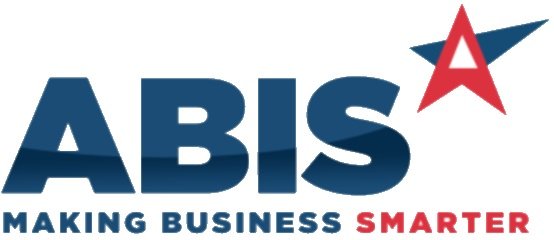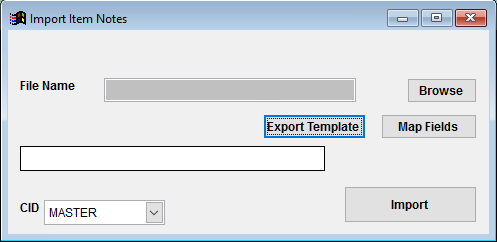Item Notes Import Guide
From Adjutant Wiki
Contents
General Import Template File Notes
- Template files are typically generated from their respective Import screen using an 'Export Template' button.
- Using the 'Export Template' button from an updated system will help ensure that you are using the most up-to-date import file, and will help avoid errors.
- Templates generally (but not in all cases) contain 3 rows of header information.
- The first row is generally labelled with f1 through f## and is used to give a consistent column id to each data column. Do not remove this row unless instructed.
- The second row is labelled with the column data/field name. The values in this row are used for the file mapping screen. Editing these values is generally not needed and may make the field mapping process difficult.
- The third row (if present) is labelled either with the same values from row 2, or with more detailed field descriptions. The third row is available to create a customer-friendly name for the associated data column.
- The third row should be removed from the source file prior to importing. It will cause errors since it will be treated as the first import record on the file.
- Import files MUST always be saved as 'Microsoft Excel 5.0/95 Workbook (*.xls)' format until further notice. The import screens will generate errors if the file type is not correct.
- It is a good idea to perform a Mapping Table Import using a current source list before beginning on any imports. Without a current mapping table, the quality of imports can be compromised. The Mapping Table Import only needs to be run once on a newly set up Adjutant system. It does not need to be run before each import.
- Export a current list from the Mapping Table Import screen from an updated system (or contact your Implementation Consultant for an updated file).
- Perform a Mapping Table Import on the target system with the XLS file from the step above.
Item Notes Import Notes
Timing and Preparation
There are no special timing or preparation details for the Item Notes Import. It can be run anytime after the item records have been added.
General Notes
There is a limit of 255 characters per Excel field that may limit the size of the note being imported. Excel will allow entry of more than 255 characters in a cell, but the spreadsheet will not save anything over 255 characters per cell.
The Adjutant note field does not have the same character limit, it is capable of handling much larger notes. You can manually add notes to the Item notes screen that exceed 255 characters. Work with the customer on editing their notes prior to import, or an alternate solution will have to be found for any notes over the 255 character limit.
The Item Notes Import replaces any existing notes upon import. It will not append, or add to existing notes. Importing a blank note value will delete the note.
Item Notes File Data Scrubbing
There are no unique requirements for scrubbing Item Notes data, other than the Excel character limit, detailed above.
Item Notes Import Screen (IMPORTITEMNOTE)
Menu Location: Transaction>>Importers/Exporters>>Item Control>>Item Note Import
File Name(Header)/Browse: Use the Browse button to locate and select the completed Item Notes Import template file (in XLS format).
Map Fields: Fields must be mapped prior to importing. If no changes have been made to the column headings, the mapping screen should show all green, and you can click OK to continue. If any of the Input Field Name columns on the left are red, single-click on the line on the left column, and then double-click the desired mapped field in the right column to complete the mapping. Repeat for any red lines on the left that should be mapped. If there are additional columns in the source file that should NOT be mapped, they can be left unmapped (displayed in red). Mandatory fields will require that they be mapped before clicking OK.
Export Template: Generates a blank Item Notes Import template.
Item Notes File Definitions
Required fields are indicated with an *
*Item - Adjutant item number
Note - Item note detail. The note will retain the spacing and carriage returns from the Excel field. There is a 255 character limit per field in Excel. Spaces count as characters.
RFQ - Enter a 'Y' to copy the note detail to the RFQ Note (Quote) screen in Item Master.
SO - Enter a 'Y' to copy the note detail to the SO Note (Sales Order) screen in Item Master.
PWO - Enter a 'Y' to copy the note detail to the PWO Note (Production Work Order) screen in Item Master.
INV - Enter a 'Y' to copy the note detail to the Inv Note (Invoice) screen in Item Master.
PO - Enter a 'Y' to copy the note detail to the PO Note (Purchase Order) screen in Item Master.
Item Notes Import Additional Steps
There are no additional steps needed after the import.
Item Notes Import Reconciliation
Reconciling imported data should begin with spot-checking several records field-by-field for complete data import. Pick records from the source file that have the most data columns filled in. Verify that all source file data fields imported correctly and display as expected.
Verify that imported note records display in the expected applications as line notes.
Item Notes Database Tables
ITEMMASTER - Notes are stored in the ITEMMASTER table under the associated item's IKEY. Each note is saved as a MEMO value in it's own field name as follows:
SO Note is saved in the ITEMNOTE field RFQ Note is saved in the RFQNOTEI field PWO Note is saved in the PWONOTEI field INV Note is saved in the INVNOTEI field PO Note is saved in the PONOTEI field

